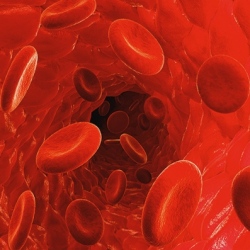
Scientists have developed “nanoneedles” that have prompted the body to generate new blood vessels, in a trial in mice. The nanoneedle technique could help damaged organs and nerves repair themselves and help transplanted organs.
In a trial described in Nature Materials, the team showed they could deliver nucleic acids DNA and siRNA to back muscles in mice. After seven days there was a six-fold increase in the formation of new blood vessels in the mouse back muscles, and blood vessels continued to form over a 14 day period.
The nanoneedles are tiny porous structures that act as a sponge to load significantly more nucleic acids than solid structures. This makes them more effective at delivering their payload. They can penetrate the cell, bypassing its outer membrane, to deliver nucleic acids without harming or killing the cell.
The nanoneedles are made from biodegradable silicon, meaning that they can be left in the body without leaving a toxic residue behind. The silicon degrades in about two days, leaving behind only a negligible amount of a harmless substance called orthosilicic acid.
The hope is that one day scientists will be able to help promote the generation of new blood vessels in people, using nanoneedles, to provide transplanted organs or future artificial organ implants with the necessary connections to the rest of the body, so that they can function properly with a minimal chance of being rejected.
“This is a quantum leap compared to existing technologies for the delivery of genetic material to cells and tissues,” said Ennio Tasciotti, Co-Chair, Department of Nanomedicine at Houston Methodist Research Institute and co-corresponding author of the paper.
“By gaining direct access to the cytoplasm of the cell we have achieved genetic reprogramming at an incredible high efficiency. This will let us personalize treatments for each patient, giving us endless possibilities in sensing, diagnosis and therapy. And all of this thanks to tiny structures that are up to 1,000 times smaller than a human hair.”
The researchers are now aiming to develop a material like a flexible bandage that can incorporate the nanoneedles. The idea is that this would be applied to different parts of the body, internally or externally, to deliver the nucleic acids necessary to repair and reset the cell programming.
